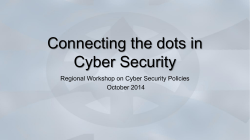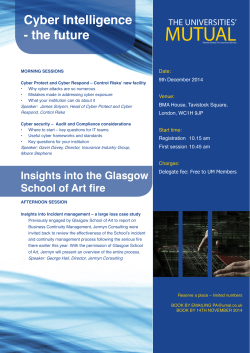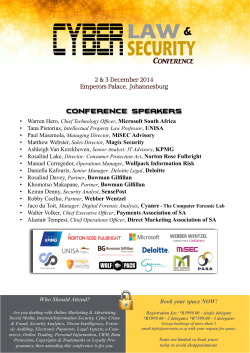
LL_EACMS_Mixed_Trust Authentication_DRAFT
Lesson Learned CIP Version 5 Transition Program Mixed Trust Authentication Environments Version: January 9, 2015 This document is designed to convey lessons learned from NERC’s various CIP version 5 transition activities. It is not intended to establish new requirements under NERC’s Reliability Standards or to modify the requirements in any existing reliability standards. Compliance will continue to be determined based on language in the NERC Reliability Standards as they may be amended from time to time. Implementation of this lesson learned is not a substitute for compliance with requirements in NERC’s Reliability Standards. Purpose The purpose of this Lesson Learned is to provide guidance related to steps entities can take to avoid mixed trust authentication environments and their associated compliance burdens. A mixed trust authentication environment refers to an implementation where a BES Cyber System shares an authentication mechanism with a corporate system. While they are not prohibited by the CIP version 5 Reliability Standards, such environments could increase an entity’s compliance burden, as discussed below. Background In practice, the security levels designed around the BES Cyber Systems are typically greater than what entities design for their corporate systems. When BES Cyber Systems and corporate systems share an authentication mechanism, such as Microsoft active directory, the resulting environment is considered to be a mixed trust environment – i.e. one platform authenticating and/or authorizing for multiple zones with different security levels. Nothing in the CIP Reliability Standards prohibits an entity from implementing a mixed trust environment and using corporate active directory servers to authenticate to an Electronic Security Perimeter or a BES Cyber Asset. If, however, an entity chooses to use corporate active directory servers to solely perform the access control function to an ESP or BES Cyber Systems, the servers are, by definition, Electronic Access Control and Monitoring Systems (EACMS) associated with one or more BES Cyber Systems. An EACMS is defined in the NERC Glossary of Terms as follow: 3353 Peachtree Road NE Suite 600, North Tower Atlanta, GA 30326 404-446-2560 | www.nerc.com Electronic Access Control or Monitoring Systems (EACMS) – Cyber Assets that perform electronic access control or electronic access monitoring of the Electronic Security Perimeter(s) or BES Cyber Systems. This includes Intermediate Systems. The Background section of Reliability Standard CIP-002-5.1 includes examples of typical EACMS, such as Electronic Access points, Intermediate Systems, authentication servers (e.g., RADIUS servers, active directory servers, certificate authorities), security event monitoring systems, and intrusion detection systems. All of the following requirements have one or more parts applicable to EACMSs associated with medium impact or high impact level BES Cyber Systems: 1. 2. 3. 4. 5. 6. 7. 8. 9. 10. 11. 12. 13. 14. 15. 16. 17. 18. 19. 20. CIP-003-6 R1 – Security Controls Management CIP-004-5 R2 – Training requirement for personnel with access to EACMS CIP-004-5 R3 – Personnel Risk Assessment Procedures CIP 004-5 R4 – Process to authorize access based on need CIP 004-5 R5 – Process for Access Revocation CIP 006-5 R1 – Physical Security Perimeter and associated processes and procedures CIP 006-5 R2 – Visitor Control Program CIP 007-5 R1 – Ports and Services CIP-007-5 R2 – Patch Management Process and Procedures CIP-007-5 R3 – Anti-malware protections CIP-007-5 R4 – Logging requirements CIP-007-5 R5 – Interactive Remote Access requirements and password requirements CIP-009-5 R1 – Recovery Plan Documentation CIP-009-5 R2 – Recovery Plan Testing CIP-009-5 R3 – Recovery Plan Testing CIP-010-2 R1 – Configuration Baseline CIP-010-2 R2 – Configuration Baseline monitoring for High Impact BCS associated EACMS CIP-010-2 R3 – Vulnerability Testing and Assessment Requirements CIP-011-1 R1 – Protection of CIP classified information CIP-011-1 R2 – Information dissemination and disposal Approach Based on the complexity of ensuring that all of the required protections be applied to EACMS in a mixedtrust environment, one of the participants in NERC’s Implementation Study for the CIP Version 5 Transition Program decided to create a separate Microsoft active directory forest dedicated to CIP environments. By taking this approach and avoiding a mixed trust environment, the entity was able to significantly reduce the compliance burden that would have resulted from inclusion of corporate active directory forest. The diagram below shows the segmentation of user authentication and the two separate trust environments. First, the user authenticates to their corporate PC as normal. The user then initiates an encrypted remote desktop session to the Intermediate System where multi-factor authentication is enforced. Once the user is authenticated at the Intermediate System, only then is the user permitted to access the Cyber Assets inside of the ESP. By taking this approach, the entity was able to leverage existing controls and infrastructure in place to meet the CIP requirements listed above while reducing the compliance burden on the corporate systems. Figure 1: Non-mixed Trust Authentication
© Copyright 2025















